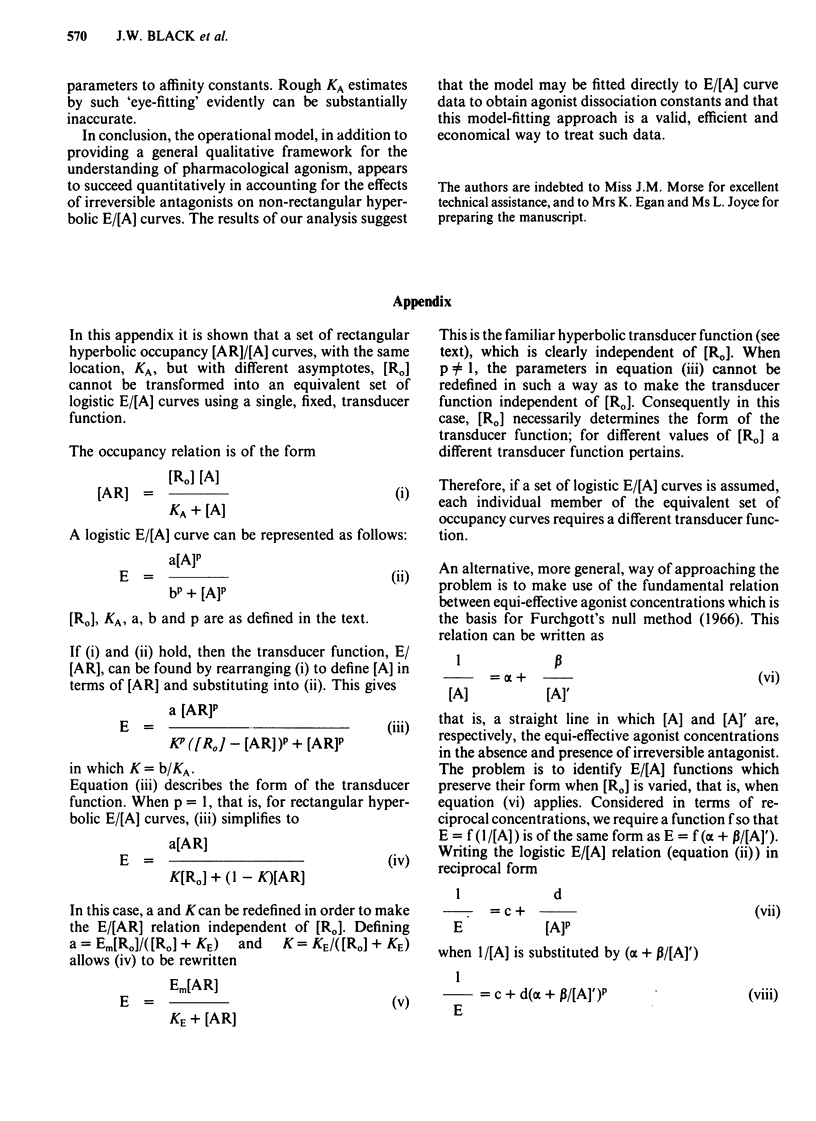Abstract
An operational model of pharmacological agonism has been analysed to predict the behaviour of rectangular hyperbolic and non-hyperbolic agonist-concentration effect, E/[A], curves with variation in receptor concentration, [Ro]. Irreversible antagonism is predicted to cause E/[A] curve gradient changes in non-hyperbolic cases but not in hyperbolic cases; in both cases estimation of agonist dissociation constants (KAS) is theoretically valid. 5-Hydroxytryptamine (5-HT) produced "steep' E/[A] curves in contracting the rabbit isolated aorta preparation. Irreversible antagonism by phenoxybenzamine (Pbz) produced a flattened E/[A] curve, consistent with theoretical predictions. Fitting 5-HT E/[A] curves in the presence and absence of Pbz to the model provided an estimate of KA for 5-HT which was not significantly different from the estimate obtained using Furchgott's null method. The operational model of agonism appears to account qualitatively and quantitatively for the effects of [Ro] changes on hyperbolic and non-hyperbolic E/[A] curves. Under conditions where irreversible antagonism may be used to estimate KAS, fitting the operational model directly to E/[A] data represents a valid, economical and analytically simple alternative to the conventional null method.
Full text
PDF










Selected References
These references are in PubMed. This may not be the complete list of references from this article.
- Apperley E., Humphrey P. P., Levy G. P. Receptors for 5-hydroxytryptamine and noradrenaline in rabbit isolated ear artery and aorta. Br J Pharmacol. 1976 Oct;58(2):211–221. doi: 10.1111/j.1476-5381.1976.tb10398.x. [DOI] [PMC free article] [PubMed] [Google Scholar]
- Barlow R. B., Scott N. C., Stephenson R. P. The affinity and efficacy of onium salts on the frog rectus abdominis. Br J Pharmacol Chemother. 1967 Sep;31(1):188–196. doi: 10.1111/j.1476-5381.1967.tb01989.x. [DOI] [PMC free article] [PubMed] [Google Scholar]
- Besse J. C., Furchgott R. F. Dissociation constants and relative efficacies of agonists acting on alpha adrenergic receptors in rabbit aorta. J Pharmacol Exp Ther. 1976 Apr;197(1):66–78. [PubMed] [Google Scholar]
- Black J. W., Leff P. Operational models of pharmacological agonism. Proc R Soc Lond B Biol Sci. 1983 Dec 22;220(1219):141–162. doi: 10.1098/rspb.1983.0093. [DOI] [PubMed] [Google Scholar]
- Dreyfus C. F., Gershon M. D., Haymovits A., Nunez E. Calcitonin: antagonism at intestinal muscarinic receptors. Br J Pharmacol. 1976 May;57(1):155–157. doi: 10.1111/j.1476-5381.1976.tb07667.x. [DOI] [PMC free article] [PubMed] [Google Scholar]
- INNES I. R. An action of 5-hydroxytryptamine on adrenaline receptors. Br J Pharmacol Chemother. 1962 Dec;19:427–441. doi: 10.1111/j.1476-5381.1962.tb01447.x. [DOI] [PMC free article] [PubMed] [Google Scholar]
- Krstew E., McPherson G. A., Malta E., Molenaar P., Raper C. Is Ro 03-7894 an irreversible antagonist at beta-adrenoceptor sites? Br J Pharmacol. 1984 Jun;82(2):501–508. doi: 10.1111/j.1476-5381.1984.tb10786.x. [DOI] [PMC free article] [PubMed] [Google Scholar]
- Marin J., Salaices M., Gómez B., Lluch S. Noradrenergic component in the vasoconstriction induced by 5-hydroxytryptamine in goat cerebral arteries. J Pharm Pharmacol. 1981 Nov;33(11):715–719. doi: 10.1111/j.2042-7158.1981.tb13911.x. [DOI] [PubMed] [Google Scholar]
- McPherson G. A., Molenaar P., Raper C., Malta E. Analysis of dose-response curves and calculation of agonist dissociation constants using a weighted nonlinear curve fitting program. J Pharmacol Methods. 1983 Dec;10(4):231–241. doi: 10.1016/0160-5402(83)90017-7. [DOI] [PubMed] [Google Scholar]
- PATON W. D., ROTHSCHILD A. M. THE CHANGES IN RESPONSE AND IN IONIC CONTENT OF SMOOTH MUSCLE PRODUCED BY ACETYLCHOLINE ACTON AND BY CALCIUM DEFICIENCY. Br J Pharmacol Chemother. 1965 Apr;24:437–448. doi: 10.1111/j.1476-5381.1965.tb01731.x. [DOI] [PMC free article] [PubMed] [Google Scholar]
- Parker R. B., Waud D. R. Pharmacological estimation of drug-receptor dissociation constants. Statistical evaluation. I. Agonists. J Pharmacol Exp Ther. 1971 Apr;177(1):1–12. [PubMed] [Google Scholar]
- STEPHENSON R. P. A modification of receptor theory. Br J Pharmacol Chemother. 1956 Dec;11(4):379–393. doi: 10.1111/j.1476-5381.1956.tb00006.x. [DOI] [PMC free article] [PubMed] [Google Scholar]
- Stollak J. S., Furchgott R. F. Use of selective antagonists for determining the types of receptors mediating the actions of 5-hydroxytryptamine and tryptamine in the isolated rabbit aorta. J Pharmacol Exp Ther. 1983 Jan;224(1):215–221. [PubMed] [Google Scholar]
- Thron C. D. Graphical and weighted regression analyses for the determination of agonist dissociation constants. J Pharmacol Exp Ther. 1970 Nov;175(2):541–553. [PubMed] [Google Scholar]
- VAN ROSSUM J. M. Cumulative dose-response curves. II. Technique for the making of dose-response curves in isolated organs and the evaluation of drug parameters. Arch Int Pharmacodyn Ther. 1963;143:299–330. [PubMed] [Google Scholar]


